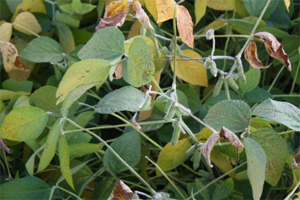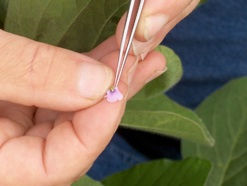Choice of Parental Germplasm
 As simple as it may sound, choosing the right parents to make a cross is not always as simple as it would seem. If you are a grower, the most obvious choice might seem to be to cross the two highest yielding varieties together, and hope that a selection from the resulting breeding population will be higher yielding than either parent. Sometimes that is exactly how a new variety is developed. However often it is not. If the two parents are very closely related to each other, all the progeny from that cross will likely be just like the two parents. In other words, no genetic gain will be obtained because there is very little genetic variability between the two parents.
As simple as it may sound, choosing the right parents to make a cross is not always as simple as it would seem. If you are a grower, the most obvious choice might seem to be to cross the two highest yielding varieties together, and hope that a selection from the resulting breeding population will be higher yielding than either parent. Sometimes that is exactly how a new variety is developed. However often it is not. If the two parents are very closely related to each other, all the progeny from that cross will likely be just like the two parents. In other words, no genetic gain will be obtained because there is very little genetic variability between the two parents.
Alternatively, if a cross is made between parents that are completely unrelated to each other, chances are high that one of the two parents is not very well adapted to the area for which a new variety is being developed. In this case, the resulting breeding population will possess huge amounts of genetic variability, but most or all of the variability may carry undesirable, unadapted “genetic baggage” from the unadapted parent.
 Therefore, a soybean breeder must always be concerned with not only the valuable characteristics of potential parents, but also the type and amount of genetic variability that might be expected from the cross of two parents.
Therefore, a soybean breeder must always be concerned with not only the valuable characteristics of potential parents, but also the type and amount of genetic variability that might be expected from the cross of two parents.
As a result, virtually all soybean breeders make a sizeable number of new crosses each year, simply because it is impossible to know with much certainty which combination of parents is going to make a breeding population with the highest probability of successful variety development.
 Some crosses will be between elite parents developed in the breeder’s program that are well adapted to the breeder’s geographic location, while other crosses will be between elite, well-adapted parents and outside germplasm sources that possess some characteristics of interest even though the outside germplasm may or may not be adapted to the area. It is important for a soybean breeding program to continually add in or introgress some outside germplasm each year in order to prevent the breeder’s germplasm base from becoming too narrow.Furthermore, if you are a soybean food processor, the most obvious choice of parents to cross together would be parents that possessed all the best processing qualities for soy milk, tofu, or other end-use food products. Once again, if the two parents are closely related, the resulting breeding population will have very little, if any, genetic variability from which to select. Again no genetic gain will occur.
Some crosses will be between elite parents developed in the breeder’s program that are well adapted to the breeder’s geographic location, while other crosses will be between elite, well-adapted parents and outside germplasm sources that possess some characteristics of interest even though the outside germplasm may or may not be adapted to the area. It is important for a soybean breeding program to continually add in or introgress some outside germplasm each year in order to prevent the breeder’s germplasm base from becoming too narrow.Furthermore, if you are a soybean food processor, the most obvious choice of parents to cross together would be parents that possessed all the best processing qualities for soy milk, tofu, or other end-use food products. Once again, if the two parents are closely related, the resulting breeding population will have very little, if any, genetic variability from which to select. Again no genetic gain will occur.
 At Galena Genetics, we make thousands of crosses among several hundred pairs of parents each year. This is not a trivial task. If you don’t believe me, I invite you out to our crossing block next summer to help make crosses! A small crew of students and myself spend many hours during the summer in the field on our hands and knees, opening flowers of one parent and pollinating them with pollen from a second parent. Soybean is a naturally self-pollinated species.
At Galena Genetics, we make thousands of crosses among several hundred pairs of parents each year. This is not a trivial task. If you don’t believe me, I invite you out to our crossing block next summer to help make crosses! A small crew of students and myself spend many hours during the summer in the field on our hands and knees, opening flowers of one parent and pollinating them with pollen from a second parent. Soybean is a naturally self-pollinated species.
Therefore, artificially manipulating and cross-pollinating the small, fragile flowers can lead to flower abortion or poor seed set in the flowers that are cross-pollinated. Cross-pollinated flowers that do set seed and produce a pod often only produce one or two seeds per pod. In fact, on average a typical student crew will only produce one hybrid seed for every two flowers cross-pollinated. However only a small number of hybrid seeds of a cross are needed to get the process started.
